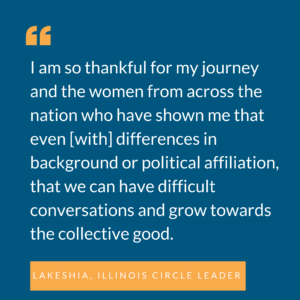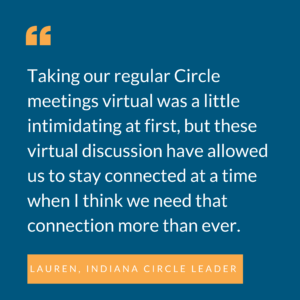Introduction
The Policy Circle curates existing research to provide you with a roadmap for informed discussions. The Policy Circle is non-partisan which means that policies and issues described in The Policy Circle briefs are not associated with any political party, candidate, or ideology. The Policy Circle briefs aim to present to the reader:
- A case study to ground the issue in reality, showing how real people are affected and implementing solutions
- Why it matters to know about the topic and engage with fellow citizens
- A brief historical context, explaining how we got to the current situation
- A definition of the issue, key terms used today, facts to know, and important statistics
- An overview of the relevant stakeholders, including:
- The role of federal, state, and local government, to hold all levels of government accountable
- The role of the private sector, to explore freedom of choice and open markets
- The role of individuals and communities, to explore local solutions led by civic institutions
- Challenges and potential reforms
- Guidance to engage locally on the issue, including next steps people can take to be involved and suggested questions for deeper discussion
- Additional resources to learn more, thought leaders to follow in order to stay up-to-date
By the end of the brief, the reader has data, definitions, and context for understanding a policy topic, be it education, poverty, or health care, as well as a better understanding of the sub-issues that make a policy debate so complicated.
Deeply understanding and debating various policy approaches is vital to a vibrant democracy, and is at the core of each Policy Circle brief.
How We Build a Brief
Brainstorming
From U.S. election reforms to environmental challenges, most issues facing Americans require asking tough questions that many try to sweep under the rug because there is no simple solution. These are the questions The Policy Circle believes can drive robust conversation and deeper understanding of policy issues. We spend time brainstorming what these tough questions are, considering views from issue experts, think tanks, and policymakers on a range of topics from immigration and foreign policy to economic growth and tax policy.
Framing the Topic
At The Policy Circle, we dive into the research and bring it all together to give our readers a comprehensive understanding of a policy issue. This involves asking the following questions:
- What are the important facts to know?
- This includes definitions, historical context, and statistics, such as the population affected by the policy issue, and public or private sector revenues and expenses.
- What is the role of government?
- This includes key federal, state, and local government agencies and resources, congressional committees, and any available data on public sector programs and budgets. We also review the constitutional separation of powers and states’ rights.
- What is the role of the private sector?
- This includes small and large businesses as well as nonprofit organizations such as philanthropies, and how they can make an impact.
- What is the role of communities?
- This includes considering stakeholders such as individuals, families, and specific vulnerable populations affected by the issue, as well as major civic institutions such as schools.
Content is gathered from credible, cited sources ranging from government data to investigative journalism and academic studies. Citations are included so you can access these in-depth sources for more information. Additionally, the briefs include interactive components such as graphs to illustrate key points, and videos to further explain important concepts.
Diving into the Challenges
Once we’ve collected the data and research to frame the issue and provide all the necessary background information, we dive into those tough questions. What are the major problems facing Americans related to this policy issue? For example, in the realm of higher education, what do we do about rising costs and student debt? To address these tough questions and the potential proposed solutions, we break things down with a SWOT analysis. SWOT stands for:
- Strengths – What works? What are the good examples of solutions that ignite creativity and entrepreneurship?
- Weaknesses – What does not work? Where has either public or private sector involvement (or lack thereof) led to poor service, high costs, or unintended consequences?
- Opportunities – What new technologies may impact the issue? What are the opportunities for reform, such as pending legislation?
- Threats – What influences may worsen the problem, or make certain solutions unsustainable either through exorbitant costs or resource depletion?
To account for different perspectives on an issue, The Policy Circle briefs cite academic studies or government data alongside the public opinion to provide context and grant respect to the rooted arguments on both sides of the issue to provide the reader a full 360-degree understanding of all valid points of view.
Committee Review
Once we have gathered the relevant information and formatted it into The Policy Circle’s organizational model, we send the first draft to a specially curated panel of subject matter experts ranging from think tank fellows; professors; policymakers at the local, state, or national level; and career experts. For example, we have included retired police officers for our Understanding Law Enforcement Brief and state financial officers for our Financial Literacy Brief.
Our reviewers ensure we have the most up-to-date, and comprehensive information available, and that we have explained the challenges and potential solutions accurately and fairly. Every point-of-view deserves a fair representation of where it originated and why it remains.
Using the Briefs
 The Policy Circle briefs are written not only to explain important issues, but to be discussed. By diving into the history, presenting all relevant positions, and grounding the brief in realistic examples, each brief provides a framework in which to have those discussions. Each brief is accompanied by an executive summary for members to quickly review key components of the brief, and a discussion guide to facilitate conversation and provide clear, actionable steps that women can take to own solutions in their communities.
The Policy Circle briefs are written not only to explain important issues, but to be discussed. By diving into the history, presenting all relevant positions, and grounding the brief in realistic examples, each brief provides a framework in which to have those discussions. Each brief is accompanied by an executive summary for members to quickly review key components of the brief, and a discussion guide to facilitate conversation and provide clear, actionable steps that women can take to own solutions in their communities.
The goal is to foster genuine connection and community amongst members, and encourage women to take action in their communities on issues that are most important to them.
Beyond the Briefs
The Policy Circle has also created additional content beyond the written briefs for our members to engage further on these important issues.
The Trust Your Voice Podcast, hosted by The Policy Circle co-founder Sylvie Légère, provides an audio version of the briefs. Each podcast episode corresponds to one of The Policy Circle’s briefs, and features subject matter experts and policy leaders to dive deeper into the issue.
The Policy Circle’s Move The Needle programming brings the briefs to life. Each virtual program is based on a brief, and provides opportunities for members and partners to connect and cover timely topics with special guests, subject matter experts, and policy leaders. Some examples of past programming include:
- Government Transparency and Accountability, featuring Adam Andrezjewski from Open the Books and Kristen Cox, former Executive Director of the Governor’s Office of Management and Budget for Utah (based on The Policy Circle’s Government Transparency and Accountability Brief)
- Mental Health in America, featuring Andy Keller, PhD, from the Meadows Mental Health Policy Institute, and Dr. Bobbi Wagner from Harvard University (based on The Policy Circle’s Mental Health Brief)
- Unpacking Socialism, featuring Dr. Emily Chamlee-Wright from the Institute for Humane Studies and Priya Brannick from the Commonwealth Foundation for Public Policy Alternatives (based on The Policy Circle’s Socialism Brief)
- Big Tech Tightrope: Balancing Free Speech, Privacy, and Innovation, featuring Rebecca MacKinnon from Ranking Digital Rights; Jillian York from the Electronic Frontier Foundation; and Steve DelBianco from NetChoice (based on The Policy Circle’s Free Speech Brief)
You can also view past panels and conversations from The Policy Circle’s Annual Leadership Summits on our Youtube page here.
The Policy Circle’s content ends with calls to action that the reader can take back to their community to spark thoughtful conversation and initiate change. Each brief includes where to start searching for more information on the policy issue, potential local contacts to reach out to, possible legislation to explore, and specific next steps to take for further engagement. The Policy Circle briefs endeavor to inspire readers with a roadmap to understand well, read deeply, listen carefully, and watch closely.